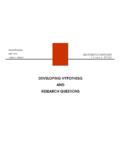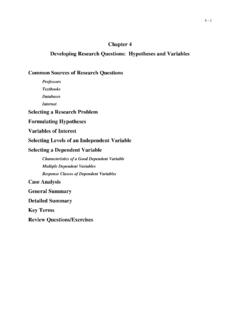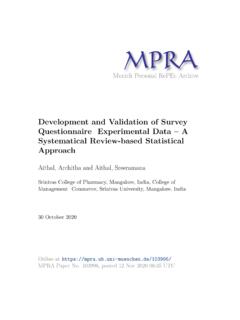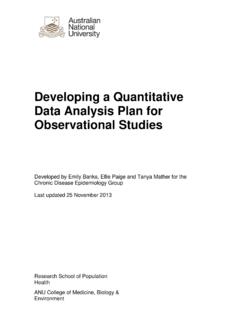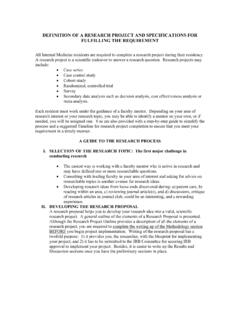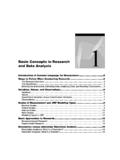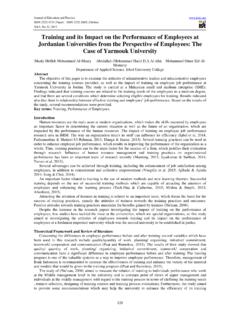Transcription of The Use of Theory - SAGE Publications Inc
1 CHAPTER THREEThe Use of Theoryone component of reviewing the literature is to determine whattheories might be used to explore the questions in a scholarlystudy. In quantitative research ,researchers often test theories asan explanation for answers to their questions. In a quantitative disserta-tion, an entire section of a research proposal might be devoted to pre-senting the Theory for the study. In qualitative research ,the use of theoryis much more varied. The inquirer may generate a Theory as the final out-come of a study and place it at the end of a project, such as in groundedtheory.
2 In other qualitative studies, it comes at the beginning and pro-vides a lens that shapes what is looked at and the questions asked, suchas in ethnographies or in advocacy research . In mixed methods research ,researchers may both test theories and generate them. Moreover, mixedmethods research may contain a theoretical lens, such as a focus onfeminist, racial, or class issues, that guides the entire begin this chapter by focusing on Theory use in a quantitative reviews a definition of a Theory , the use of variables in a quantitativestudy, the placement of Theory in a quantitative study, and the alterna-tive forms it might assume in a written plan.
3 Procedures in identifying atheory are next presented, followed by a script of a theoretical per-spective section of a quantitative research proposal. Then the discus-sion moves to the use of Theory in a qualitative study. Qualitativeinquirers use different terms for theories, such as patterns, theoreticallens, or naturalistic generalizations, to describe the broader explana-tions used or developed in their studies. Examples in this chapter illus-trate the alternatives available to qualitative researchers. Finally, thechapter turns to the use of theories in mixed methods research and theuse of a transformative perspective that is popular in this Theory USEV ariables in Quantitative ResearchBefore discussing quantitative theories, it is important to understandvariables and the types that are used in forming theories.
4 A variablerefers4903-Creswell (RD)-45593:03-Creswell (RD) 6/20/2008 4:36 PM Page 4950to a characteristic or attribute of an individual or an organization that canbe measured or observed and that varies among the people or organizationbeing studied (Creswell, 2007a). A variable typically will vary in two ormore categories or on a continuum of scores, and it can be measured orassessed on a scale. Psychologists prefer to use the term construct (ratherthan variable ), which carries the connotation more of an abstract ideathan a specifically defined term.
5 However, social scientists typically use theterm variable ,and it will be employed in this discussion. Variables oftenmeasured in studies include gender, age, socioeconomic status (SES), andattitudes or behaviors such as racism, social control, political power, orleadership. Several texts provide detailed discussions about the types ofvariables one can use and their scales of measurement ( , Isaac & Michael,1981; Keppel, 1991; Kerlinger, 1979; Thorndike, 1997). Variables are dis-tinguished by two characteristics: temporal order and their measurement(or observation).
6 Temporal ordermeans that one variable precedes another in of this time ordering, it is said that one variable affects or causesanother variable , though a more accurate statement would be that onevariable probablycauses another. When dealing with studies in the naturalsetting and with humans, researchers cannot absolutely prove causeand effect (Rosenthal & Rosnow, 1991), and social scientists now say thatthere is probable causation. Temporal order means that quantitativeresearchers think about variables in an order from left to right (Punch,2005) and order the variables in purpose statements, research questions,and visual models into left-to-right, cause-and-effect presentations.
7 Thus, Independent variables are those that (probably) cause, influence, oraffect outcomes. They are also called treatment, manipulated, antecedent, orpredictorvariables. Dependent variables are those that depend on the independent vari-ables; they are the outcomes or results of the influence of the independentvariables. Other names for dependent variables are criterion, outcome, andeffectvariables. Intervening ormediating variables stand between the independent anddependent variables, and they mediate the effects of the independentvariable on the dependent variable .
8 For example, if students do well on aresearch methods test (dependent variable ), that result may be due to(a) their study preparation (independent variable ) and/or (b) their organiza-tion of study ideas into a framework (intervening variable ) that influencedtheir performance on the test. The mediating variable , the organization ofstudy, stands between the independent and dependent variables. Moderating variables are new variables constructed by a researcher bytaking one variable and multiplying it by another to determine the jointPreliminary Considerations03-Creswell (RD)-45593:03-Creswell (RD) 6/20/2008 4:36 PM Page 50 The Use of Theoryimpact of both ( , age X attitudes toward quality of life).
9 These variablesare typically found in experiments. Two other types of variables are control variablesand confoundingvariables. Control variables play an active role in quantitative are a special type of independent variable that researchers measurebecause they potentially influence the dependent variable . Researchersuse statistical procedures ( , analysis of covariance) to control for thesevariables. They may be demographic or personal variables ( , age orgender) that need to be controlled so that the true influence of the inde-pendent variable on the dependent can be determined.
10 Another type ofvariable, a confounding (or spurious) variable ,is not actually measured orobserved in a study. It exists, but its influence cannot be directly comment on the influence of confounding variables after thestudy has been completed, because these variables may have operated toexplain the relationship between the independent variable and dependentvariable, but they were not or could not be easily assessed ( , discrimi-natory attitudes).In a quantitative research study, variables are related to answer aresearch question ( , How does self-esteem influence the formation offriendships among adolescents?)










